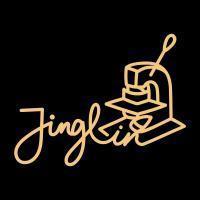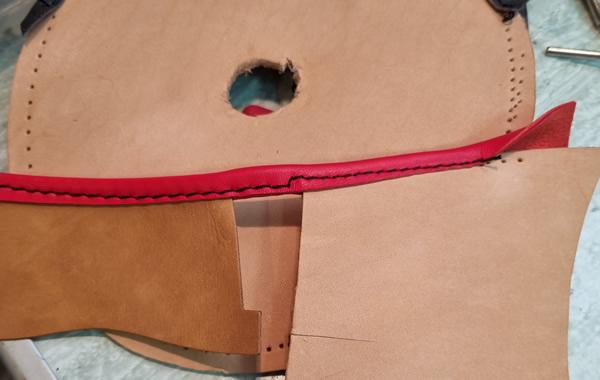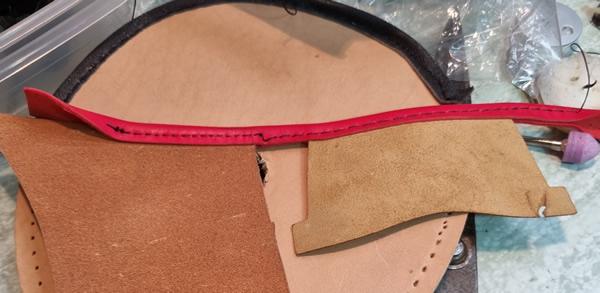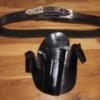All Activity
- Today
-
Sorry for my part. I had my jackass pants on that day. Jim
-
"made by sum yung gui hung lo". Made I larf that did. If I'd said it Tom would've told me off. (Just kidding Tom.) I've drooled over such set ups on YouTube Wiz. Don't get me wrong Wiz, I'm not shy when it comes to spending money when it's right and if I had such contracts I would do the same. I've no doubt that eventually I'll end up with something decent and by the time I've learned what I need to know and enjoyed playing I'll be able to do it with a flourish. Here's todays effort. The red is just over 1mm, the veg tan is 2.5 and 1mm. The red is 18mm
-
I spent good money on a binding setup for my Adler 69 and got nowhere with it, probably my fault but there you are. I bought one folder from JL but it's too small. Maybe it'll come good later. Don't give up.
-
Way back in the late 1980s, I had a job setting up a sewing operation that required applying edge binding to the items being sewn. I started out with an over-the-counter folder and some bias tape in 3 foot lengths from a store. The results were a disaster! I called my industrial sewing machines dealer and he recommended that I contact a guy who custom built folders and other sewing machine attachments.I got together with that fellow, showing him a sample of the material I was working with. He designed and built a double folder attachment that fitted onto or across the bed of the Juki LU-563 that I was going to use. The folder was made to double fold bias tape that was sold on huge rolls. It was 1.25 inches wide and I believe was polyester material. The roll sat on top of a platter that was mounted onto the right-rear end of the table. The platter rotated freely under adjustable spring tension. I set it to prevent the roll from free-wheeling when I sewed fast. This setup worked flawlessly. The edges were about 5/16 inch down from the top and were sewn a little over 1/16 inch above their bottom folded edge. The material being covered measured about 1/16 inch thick along the edges. It was an orange honeycomb material that I made into safety vests worn by road workers when they were on the job on highways and byways. I also 2" wide sewed yellow Reflexite strips across the front and back, plus sewed a patch on the back identifying who they worked for. This eventually morphed into reflective vests for transit works and Police officers. The bottom line here is that if you need to sew edge binding onto goods for sale, go the extra mile and have one made or modified to work with your preferred edge tape and sewing machine. A fully matched set of parts will work more reliably than miscellaneous parts from hither and thence, made by sum yung gui hung lo.
-
I spent a day with a binder on my pfaff-545 and could not get the bottom and top sides to be even. I conjectured that to get them even the entrance runway (the zig zag of wire) would need to be horizontal, whereas mine was canted upwards to clear the flatbed. My best plan at the time was to stitch from the wrong side of the fabric, since the bottom of the binder always had less coverage than the top. That way the stitches on the right side of the fabric could be close and tidy to the edge of the binding. I bought two binding attachments with my JL 341, but have not used them. When I ordered them they were specific about asking what kind of tape I wanted to use---both its width and its thickness.
-

How to Subscribe to Everything in a Single Forum
friquant replied to friquant's topic in Computer Help
That does seem to be the pattern for the other missing notifications as well. I'll figure out a game plan for those 🍹 -
.thumb.jpg.6e903dd66163ad5672f00f144058c571.jpg)
Thinking of making my own tack (questions)
Northmount replied to RestlessHands's topic in Saddle and Tack Accessory Items
I moved your post to Saddle and Tack Accessory Items. There are other related sub-forums here as well. Have a look through them and you may find some of the answers that you are looking for. Did you know that you can edit your posts? The time window for editing is about 2 hours. Look for the 3 dots at the top right of a post, pick it, then pick edit. This way, you can add info, fix typos, correct statements, etc.- 2 replies
-
- treeless saddle
- painting
-
(and 1 more)
Tagged with:
-
Thinking of making my own tack (questions)
RestlessHands replied to RestlessHands's topic in Saddle and Tack Accessory Items
Ah and, completely forgot. I need tips on painting/decorating leather that actually is resistant to light wear (skirting, fenders, back of cantle) as well as where people get their sale hardware from. Sorry for the inconvenience, thanks- 2 replies
-
- treeless saddle
- painting
-
(and 1 more)
Tagged with:
-
I have made various things from leather and I feel like tackling a larger project. Whether that's me making tack to sell or making tack for me, I'm interested in how the complexity of certain things work. I'm vaguely aware of how to create a treed saddle, but what I'm really interested in is treeless (seems like a "horse girl" thing so maybe lucrative lol) and so now I'm trying to figure out how to make treeless saddles that aren't shit, with proper wither clearance. Also, instead of asking The Google I was wondering what your favorite measurements for things like headstalls and breastcollars are. Thanks!
- 2 replies
-
- treeless saddle
- painting
-
(and 1 more)
Tagged with:
-
The place to sell items is in the Marketplace. Moved your detailed post there.
-
SGG84 joined the community
-
I have bought sample cowhide skins from mainly Samanta and Opera over the past few years, that I have then decided not to include in the range, and so would like to sell. They are lovely quality and would all have cost me approx £65 - £80 per m2 - I would sell those that are up to 1.5m for £50 a skin, and for above that size at £100 - plus shipping. If you would like more information / pictures etc, please reply to this post. sale leathers .pdf
-
New pistol, new holster
Samalan replied to Thadrick's topic in Gun Holsters, Rifle Slings and Knife Sheathes
Wow, that's a beauty! -
Boss says I might get a promotion before they put me in the old folks home. I trained for years at a desk job shoveling horse sh*t, never dreaming that I'd make the big show shoveling the real thing. This is better. Thanks, Jonas. The harness leather burnishes more easily than the HO bridle. I guess the waxes in the leather help the process. I can only blame myself for my previous stretchy belt. It was not heavy enough to stand up to the heat and humidity - was always damp. Thank you. I am all about sewing fixed loops and buckles on bridles, but I did manage to get some uneven stitches on this belt.
-
Nice job on those. I like the hand stitching just behind the buckle, and the edges are slicked nicely.
-
Great job Tom. Yesterday I tightened up the belt that came with the trousers and the buckle came off! I had to find my belt before I could go out.
-
Peachy Belts joined the community
-
I have some leather skins to sell and would like to put them on the leatherworker forum
-
It always amazes me when you guys take the time to educate us lower mortals and I thank you for it but what you describe is above my pay grade. I'm about to sell my flatbed because I have no room for it. I have no room for anything. I came from a 4bed house in London to a 2 bed bungalow in Kent. One of those bedrooms is my "shop" I have one 341 machine and I'm hoping that eventually I can fashion something that won't take much to change from normal sewing to a basic binder. If I have to change out a couple bits then so be it but this is still not much more than a hobby and I'm loving it but without a brand and the supermarkets selling handbags for £15/20 there's not much chance of making any money and that's fine as long as I'm enjoying it. Back to the binder, the leather that I used is 0.8mm and actually fed through easily. I have lots of that kind of leather in many colours so I'm hoping I can use it. Don't know if it will go through a double folder, we'll see. I will be buying some ready made stuff to see what works and what doesn't. After thinking about my problem above there's one more thing to try that should've been obvious, the vertical axis. If I lean the folder out slightly and re-adjust surely that will even out the amount on each side?? We'll surely find out. Thanks again guys for all your help as always.
-
Looking really good! You are exceptionally good at making those nice looking edges! Brgds Jonas
-
Mr.E Crafts joined the community
-
To use leather as edge binding, it should be as slippery as possible so it flows through the binder attachment. Glazed pigskin lining leather that Tandy Leather sells in the US and Canada comes to mind. It is very thin, usually under 2 ounces thickness, strong (I use it for wallet interiors and holster linings), and slippery on both sides. It would probably work well in a double-fold binder. Sometimes, getting leather to work in a folder attachment just doesn't work out as you hoped for. Here's a Plan B for you. I have a buddy nearby who makes high-end holsters, rifle slings, guitar straps and tooled belts. He manually installs thin lambskin edge binding on many of his projects by laying it flat on the outside, grain side against the outside edge of the project (grain to grain). He uses 1/4 inch wide double-sided leather tape to hold the lining to the project, along the very top. He bends and folds the lamb ski to follow the contours of the project, then sews it on just below the bottom of the double-sided basting tape. This ensures that the needle just misses the 1/4 inch sticky tape. After he has sewn the edge strip onto the project's from side, he applies another strip of tape to the visible bottom edge of the lining material, then pulls it up and over the top edge of the project. He pulls it tightly over the top and presses it down to the inside of the project. The edging on the back should hang below the stitch line done on the front side. The tape should hold it in place. Once he is satisfied with how the edging lays on both sides, he takes it back to his sewing machine and sew through the front side, just under the double-folded edge. This captures the longer piece that is folded over to the inside. He cuts the width of the edge leather so that is folds nicely and tightly on the front and hangs just far enough down on the back for the needle to capture it. A typical binding from him would have about 1/4 inch folded over on the front and 3/8 inch protruding on the back side. Sometimes, he uses precision scissors to trim the back side after it's sewn on. When the sewing is finished, the edges are double-folded on the outside and single folded on the back. The grain side is all the customer sees on either side. The above method may be unconventional, but his customers like it and haven't complained about it getting in the way, or coming apart. I believe that he uses about 2 ounce thickness lambskins as edge bindings. He doesn't need a binder at all. He uses his left toe presser foot on his Cobra Class 4 stitcher, with a #23 needle running either #138 or #207 bonded nylon thread. His machine has been modded with a narrow feed dog, with a smaller than stock hole, and matching throat plate to prevent soft leather from getting pushed down into the bottom feed parts. If you want to try using his system to apply lambskin edging, purchase quality skins that are as long as possible. Aim for about 1.5 minimum to 2 ounces maximum thickness. I buy the double-sided basting tape from Wawak.com. Other companies may carry a different brand that has a greater or lesser holding strength. Note, if you will be sewing through double-sided basting tape, use titanium coated needles with as large an eye as possible. Keep a small glass jar filled with Goof-Off nearby and use a small wool dauber to dip in into the liquid solvent. Rub the wet dauber over the needle every now and then to dissolve and remove any adhesive residue from the tape. Failure to clean the needle will result in the top thread sticking in the needle's rib and eye, leading to skipped stitches and ratted top thread.
-
How to Subscribe to Everything in a Single Forum
Johanna replied to friquant's topic in Computer Help
It looks like the particular topic you linked was transferred into the Sewing Machine Forum by Northmount at about 8:30 pm, because he thought it would get more specific attention from you sewing machine experts there. -
Go to Ebay . . . search for what you have . . . compare theirs with yours . . . and price accordingly. You will really not beat that way of doing it . . . for the price it costs you to do it. May God bless, Dwight
-

guide Pencil Hot Stamping Guide
Jinglin posted a blog entry in How Does a Hot Foil Stamping Machine Work?
Introduction Hot foil stamping on pencils is a unique way to turn everyday stationery into eye-catching, personalized gifts. With a metallic finish in gold, silver, or rose gold, even a simple wooden pencil can become a premium keepsake. This technique is widely used for corporate giveaways, school souvenirs, wedding favors, and brand promotions. Whether you are a stationery business owner, a leather & craft workshop, or a DIY enthusiast, this guide will walk you through the complete process of pencil foil stamping—From selecting the right hot foil stamping machine to tips for achieving a clean, long-lasting finish, we’ll cover every step in the process. Read on to discover how you can start creating custom foil-stamped pencils that stand out. What is Pencil Hot Foil Stamping? Hot foil stamping is a printing technique that uses heat and pressure to transfer metallic foil onto a surface. In pencil applications, the foil is applied to the curved surface of the pencil body, creating a shiny, durable design. Unlike flat leather or paper stamping, pencil foil stamping requires precision positioning because of the pencil’s small diameter and round shape. The key to success is using the right jig or holder to keep the pencil steady during stamping. Tools & Materials Needed To start stamping pencils, you will need: Mini Hot Foil Stamping Machine – A compact model with adjustable temperature and pressure (ideal for small cylindrical objects). Brass Letter Stamps or Custom Brass Logo Dies – For names, initials, or brand logos. Stamping Foil – Gold, silver, rose gold, or custom colors suitable for wood and lacquer surfaces. Pencil Holder – Ensures the pencil stays in place and aligned during stamping. Heat-Resistant Gloves – For safe handling of heated parts. Step-by-Step Guide to Foil Stamping on Pencils 1. Design & Prepare the Stamp Decide on your design—this could be a name, logo, or special date. For the best results, use engraved brass letter stamps or a custom brass die. 2. Set Up the Machine Set the temperature between 100°C–130°C (adjust based on foil type and pencil surface). Adjust pressure to ensure firm contact without damaging the pencil. 3. Position the Pencil Place the pencil in a cylindrical holder or jig to keep it from rolling. Align the stamp with the exact position where you want the foil design to appear. 4. Apply Foil & Stamp Insert the foil between the stamp and the pencil. Apply pressure for 2–4 seconds to transfer the foil evenly. 5. Cooling & Inspection Let the pencil cool before removing it from the holder. Check the stamped area for complete foil coverage and sharp edges. Tips for Perfect Results Use high-quality foil to prevent peeling or fading. For lacquer-coated pencils, choose foil designed for coated or painted surfaces. Test on a sample pencil before doing bulk production. Keep the stamp clean to avoid unwanted marks. Creative Applications Personalized Gifts – Names or inspirational quotes. Wedding Favors – Couple’s initials and wedding date. Corporate Branding – Logo and slogan for promotional giveaways. School Events – Graduation year or school name. Common Questions and Solutions (User Pain Points) How to properly adjust temperature and pressure? It is recommended to start testing at a low temperature (around 100°C) and gradually increase to the ideal setting. Pressure should be sufficient to firmly adhere the foil but not so high as to leave indentations on the pencil body. How to avoid damaging the pencil surface or foil bubbling? For painted surfaces, use low-temperature foil and shorten the stamping time to prevent prolonged high heat exposure. Which foil is suitable for wooden or painted pencils? Wooden surfaces can use general-purpose foil, while painted surfaces require special coated surface foil for better adhesion. How to prevent the pencil from rolling during stamping? Use a dedicated cylindrical clamp or V-shaped groove worktable, and assist alignment with red laser positioning or ruler measurements before stamping. What to do if the stamping fails? Incomplete foil transfer → Increase pressure or extend stamping time. Blurred foil surface → Lower temperature or shorten stamping time. Fuzzy edges → Check if the mold surface is clean. Conclusion By mastering these steps and troubleshooting tips, you can achieve precise and flawless foil stamping on every pencil. Remember: slow adjustments, multiple tests, controlling temperature and pressure, and using proper fixtures—these four points are the key to success. - Yesterday
-
ptochman joined the community
-

How to Subscribe to Everything in a Single Forum
AlZilla replied to friquant's topic in Computer Help
Personally, I haven't a clue. Just go to the top and click "Activity", scroll through everything. -
Is following a subforum expected to be reliable? A month or so ago I set myself as following the Leather Sewing Machines subforum. Since then I've only been reading things I see notifications for, which I assumed would be all the new posts in that subforum, plus replies to things I've replied to. Today I stumbled upon some new posts in the same subforum that I had not seen and that did not show up in my notifications. Example post that I did not receive a notification for: https://leatherworker.net/forum/topic/131587-binding-attachment-from-china/ That was posted on Thursday. Here is a screenshot of my notifications for thursday @Johanna for visibility







